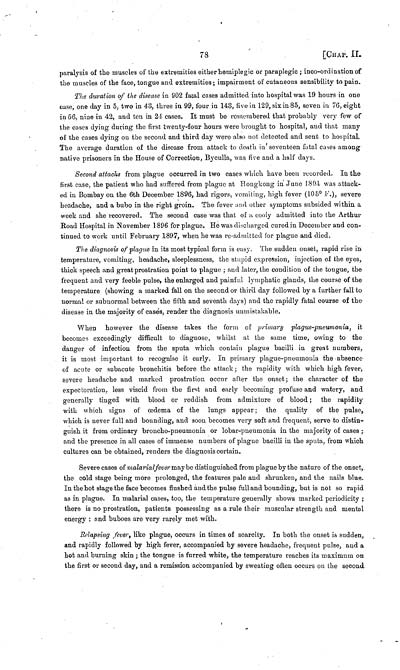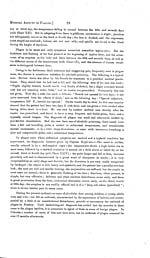Medicine - Disease > Bombay plague: being a history of the progress of plague in the Bombay presidency from September 1896 to June 1899
(108) Page 78
Download files
Individual page:
Thumbnail gallery: Grid view | List view

78 [CHAP. II.
paralysis of the muscles of the extremities either hemiplegic or paraplegic; inco-ordination of
the muscles of the face, tongue and extremities; impairment of cutaneous sensibility to pain.
The duration of the disease in 902 fatal cases admitted into hospital was 19 hours in one
case, one day in 5, two in 43, three in 99, four in 143, five in 129, six in 85, seven in 76, eight
in 56, nine in 42, and ten in 24 cases. It must be remembered that probably very few of
the cases dying during the first twenty-four hours were brought to hospital, and that many
of the cases dying on the second and third day were also not detected and sent to hospital.
The average duration of the disease from attack to death in seventeen fatal cases among
native prisoners in the House of Correction, Byculla, was five and a half days.
Second attacks from plague occurred in two cases which have been recorded. In the
first case, the patient who had suffered from plague at Hongkong in June 1894 was attack-
ed in Bombay on the 6th December 1896, had rigors, vomiting, high fever (105 F.), severe
headache, and a bubo in the right groin. The fever and other symptoms subsided within a
week and she recovered. The second case was that of a cooly admitted into the Arthur
Road Hospital in November 1896 for plague. He was discharged cured in December and con-
tinued to work until February 1897, when he was re-admitted for plague and died.
The diagnosis of plague in its most typical form is easy. The sudden onset, rapid rise in
temperature, vomiting, headache, sleeplessness, the stupid expression, injection of the eyes,
thick speech and great prostration point to plague; and later, the condition of the tongue, the
frequent and very feeble pulse, the enlarged and painful lymphatic glands, the course of the
temperature (showing a marked fall on the second or third day followed by a further fall to
normal or subnormal between the fifth and seventh days) and the rapidly fatal course of the
disease in the majority of cases, render the diagnosis unmistakable.
When however the disease takes the form of primary plague-pneumonia, it
becomes exceedingly difficult to diagnose, whilst at the same time, owing to the
danger of infection from the sputa which contain plague bacilli in great numbers,
it is most important to recognise it early. In primary plague-pneumonia the absence
of acute or subacute bronchitis before the attack; the rapidity with which high fever,
severe headache and marked prostration occur after the onset; the character of the
expectoration, less viscid from the first and early becoming profuse and watery, and
generally tinged with blood or reddish from admixture of blood; the rapidity
with which signs of dema of the lungs appear; the quality of the pulse,
which is never full and bounding, and soon becomes very soft and frequent, serve to distin-
guish it from ordinary broncho-pneumonia or lobar-pneumonia in the majority of cases;
and the presence in all cases of immense numbers of plague bacilli in the sputa, from which
cultures can be obtained, renders the diagnosis certain.
Severe cases of malarial fever may be distinguished from plague by the nature of the onset,
the cold stage being more prolonged, the features pale and shrunken, and the nails blue.
In the hot stage the face becomes flushed and the pulse full and bounding, but is not so rapid
as in plague. In malarial cases, too, the temperature generally shows marked periodicity;
there is no prostration, patients possessing as a rule their muscular strength and mental
energy; and buboes are very rarely met with.
Relapsing fever, like plague, occurs in times of scarcity. In both the onset is sudden,
and rapidly followed by high fever, accompanied by severe headache, frequent pulse, and a
hot and burning skin; the tongue is furred white, the temperature reaches its maximum on
the first or second day, and a remission accompanied by sweating often occurs on the second
paralysis of the muscles of the extremities either hemiplegic or paraplegic; inco-ordination of
the muscles of the face, tongue and extremities; impairment of cutaneous sensibility to pain.
The duration of the disease in 902 fatal cases admitted into hospital was 19 hours in one
case, one day in 5, two in 43, three in 99, four in 143, five in 129, six in 85, seven in 76, eight
in 56, nine in 42, and ten in 24 cases. It must be remembered that probably very few of
the cases dying during the first twenty-four hours were brought to hospital, and that many
of the cases dying on the second and third day were also not detected and sent to hospital.
The average duration of the disease from attack to death in seventeen fatal cases among
native prisoners in the House of Correction, Byculla, was five and a half days.
Second attacks from plague occurred in two cases which have been recorded. In the
first case, the patient who had suffered from plague at Hongkong in June 1894 was attack-
ed in Bombay on the 6th December 1896, had rigors, vomiting, high fever (105 F.), severe
headache, and a bubo in the right groin. The fever and other symptoms subsided within a
week and she recovered. The second case was that of a cooly admitted into the Arthur
Road Hospital in November 1896 for plague. He was discharged cured in December and con-
tinued to work until February 1897, when he was re-admitted for plague and died.
The diagnosis of plague in its most typical form is easy. The sudden onset, rapid rise in
temperature, vomiting, headache, sleeplessness, the stupid expression, injection of the eyes,
thick speech and great prostration point to plague; and later, the condition of the tongue, the
frequent and very feeble pulse, the enlarged and painful lymphatic glands, the course of the
temperature (showing a marked fall on the second or third day followed by a further fall to
normal or subnormal between the fifth and seventh days) and the rapidly fatal course of the
disease in the majority of cases, render the diagnosis unmistakable.
When however the disease takes the form of primary plague-pneumonia, it
becomes exceedingly difficult to diagnose, whilst at the same time, owing to the
danger of infection from the sputa which contain plague bacilli in great numbers,
it is most important to recognise it early. In primary plague-pneumonia the absence
of acute or subacute bronchitis before the attack; the rapidity with which high fever,
severe headache and marked prostration occur after the onset; the character of the
expectoration, less viscid from the first and early becoming profuse and watery, and
generally tinged with blood or reddish from admixture of blood; the rapidity
with which signs of dema of the lungs appear; the quality of the pulse,
which is never full and bounding, and soon becomes very soft and frequent, serve to distin-
guish it from ordinary broncho-pneumonia or lobar-pneumonia in the majority of cases;
and the presence in all cases of immense numbers of plague bacilli in the sputa, from which
cultures can be obtained, renders the diagnosis certain.
Severe cases of malarial fever may be distinguished from plague by the nature of the onset,
the cold stage being more prolonged, the features pale and shrunken, and the nails blue.
In the hot stage the face becomes flushed and the pulse full and bounding, but is not so rapid
as in plague. In malarial cases, too, the temperature generally shows marked periodicity;
there is no prostration, patients possessing as a rule their muscular strength and mental
energy; and buboes are very rarely met with.
Relapsing fever, like plague, occurs in times of scarcity. In both the onset is sudden,
and rapidly followed by high fever, accompanied by severe headache, frequent pulse, and a
hot and burning skin; the tongue is furred white, the temperature reaches its maximum on
the first or second day, and a remission accompanied by sweating often occurs on the second
Set display mode to: Large image | Zoom image | Transcription
Images and transcriptions on this page, including medium image downloads, may be used under the Creative Commons Attribution 4.0 International Licence unless otherwise stated. ![]()
| India Papers > Medicine - Disease > Bombay plague: being a history of the progress of plague in the Bombay presidency from September 1896 to June 1899 > (108) Page 78 |
|---|
| Permanent URL | https://digital.nls.uk/74586184 |
|---|




